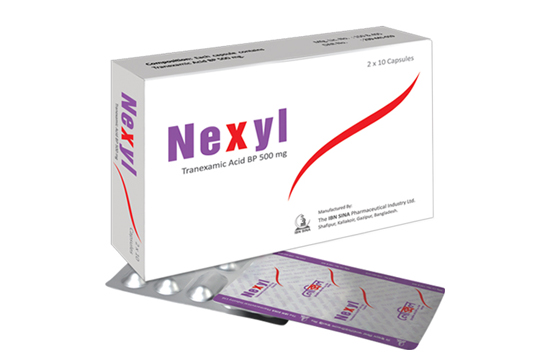
NEXYL
TRANEXAMIC ACID BP
| NAME | STRENGTH | PACK SIZE | DOSAGE FORM |
|---|---|---|---|
| NEXYL 500 MG | 500 MG | 20 S | CAPSULE |
Nexyl Capsule : Each capsule contains Tranexamic Acid BP 500 mg.
Tranexamic acid has a strong inhibitory effect on the activation of plasminogen, i.e. the conversion of plasminogen to plasmin, in the fibrinolytic system. The half-life is 1-2 hours. Plasma protein binding is 3% at therapeutic levels. The plasma protein binding seems fully accounted by its binding to plasminogen. Tranexamic acid is excreted unchanged in the urine. Tranexamic acid is rapidly absorbed from the gastrointestinal tract. Maximum serum levels are reached within 2-3 hours. After oral administration, about 40% of the dose is excreted in the urine during the first 24 hours. After intravenous administration, 45% of the dose is excreted in the urine during the first day.
Haemorrhage or risk of haemorrhage in increased fibrinolysis or fibrinogenolysis that may occur in conditions: a). Menorrhagia, b). Prostatectomy and bladder surgery, c). Epistaxis, d). Conisation of the cervix, e). Management of dental extraction in patients with coagulopathies, f). Ulcerative colitis, g). Haematuria, h). Gastrointestinal haemorrhage, i). General fibrinolysis as in prostatic and pancreatic cancer, after thoracic and other major surgery, in obstetrical complications such as abruptio placentae and post-partum haemorrhage, in leukaemia and liver diseases and in connection with thrombolytic therapy with streptokinase, j). Hereditary angioneurotic oedema.
2-3 capsules 3 times daily for maximum 5 days during menstruation.
Active thromboembolic disease, such as deep vein thrombosis, pulmonary embolism and cerebral thrombosis Subarachnoid haemorrhage Hypersensitivity to tranexamic acid or any of the ingredients.
Patients with irregular menstrual bleeding, patients with a high risk of thrombosis (a previous thromboembolic event and a family history of thromboembolic disease) should use it only if there is a strong medical indication and under strict medical supervision.
Patients with disseminated intravascular coagulation (DIC), who require treatment with it must be under the strict supervision of a physician experienced in treating this disorder.
In the long-term treatment of patients, regular eye examination should be performed. If a colour vision disorder occurs during the course of treatment, the drug should be discontinued.
Dose-dependent gastrointestinal discomfort is the most commonly reported undesirable effect, but it is usually of mild and temporary in nature. Allergic skin reactions have been reported as an uncommon undesirable effect. Hypotension may occur after fast injection.
Pregnancy: Tranexamic acid crosses the placenta. Clinical experience of use in pregnant women is limited. Animal studies have not supplied any evidence of an increased incidence of foetal damage. Lactation: Tranexamic acid is excreted into breast milk, but it is not likely to influence the child at therapeutic doses.
undefined
Tranexamic Acid is a synthetic Amino Acid that is incompatible with solutions containing penicillins (eg: Benzyl
penicillin). Thrombolytic drugs like Streptokinase & Urokinase antagonise the antifibrinolytic action of Tranexamic
Acid. The potential for thrombus formation may be increased by concomitant administration of estrogen containing
drugs, like oral contraceptives. Direct admixture of Tranexamic Acid with whole blood should be avoided during
Transfusion.
No data available
Stored between 15°C to 30° C and protected from light and moisture.
Nexyl Capsule: Each box contains 62 x 10's capsules in blister pack.
